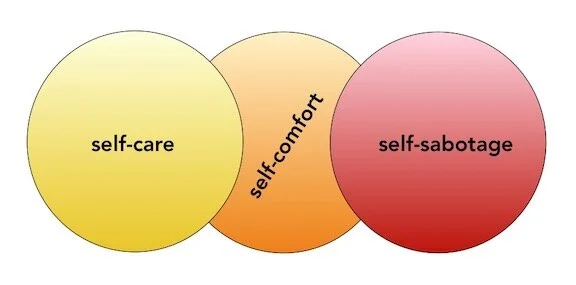Strange Territory of Self-Comfort
When someone clears their throat in a room, we pay attention. It’s a universal signal that someone is preparing to speak with intention. We clear our throats so our voices will lift strong and clear, so we can not only be heard, but listened to.
Lately, I have been working to listen to all the ways the world around me is clearing its throat, all the ways it is asking me to pay attention and then lend my own voice to what I’m taking in.
A while back, I learned about noticing the distinction between self-care and self-comfort. It’s been very helpful to me, and ever since then, I’ve known I would write about it. But I’ve been waiting for my own practice, conversations, and insights to gestate into readiness.
Recently, I incorporated the theme of self-care vs. self-comfort into a yoga class I taught. Afterward, multiple people expressed curiosity. Could one behavior fall into both categories? Did the difference have to do more with one’s attitude and orientation toward an action? Was self-care better than self-comfort? Conversations ensued.
We easily came up with examples where self-care and self-comfort overlap—like breathing deeply, spending time in nature, eating a nourishing meal, starting the day with an intentional morning practice.
And what about the distinction between them? Some examples of self-care that don’t necessarily overlap with self-comfort might include shopping for groceries, some exercise, paying bills, or practicing a new skill. And of course, skipping the chocolate might be a self-care move, but boy would the part of us craving comfort sure like to say yes to it.
Then we started to wonder about choices like having that second glass of wine, or spending a whole day bundled on the couch deep in a Netflix glow…overindulging in any way, really. You know these moments. They are the ones where we tell ourselves “I deserve this; I’ve earned this; I need this to relax.” Sometimes, those sentiments are entirely true and related to self-care. And other times, these choices become slippery slopes into something different and darker. I realized that a third element—the shadowy world of self-sabotage—also belongs in this picture. I learned that self-comfort is tricky territory. Here’s how I’m seeing the relationship now:
Ahimsa (Ahem-sa?)
In yoga, there is foundational observance (or yama) called ahimsa, meaning nonviolence and compassion.
Ahimsa (a Sanskrit term) is the first of five observances those who study yoga learn about. The five yamas are part of the full “eight-limbed path” of yoga. (Fun fact: though the commonly held perspective of yoga in the U.S. is that it is predominately a form of exercise, the physical sequence of postures makes up only 2% of historical teachings about yoga.) The study of ahimsa is step one of limb one, because it is absolutely foundational for everything that follows.
Ahimsa is the opposite of self-sabotage. In her book The Yamas and Niyamas, Deborah Adele writes:
“…how we treat ourselves is in truth how we treat those around us. If you are a taskmaster with yourself, others will feel your whip. If you are critical of yourself, others will feel your high expectations of themselves as well. If you are light hearted and forgiving with yourself, others will feel the ease and joy of being with you. If you find laugher and delight in yourself, others will be healed in your presence.”
It might be counter-intuitive, but a good way to develop ahimsa is to start by acknowledging the many ways we harm ourselves. We all do this; for whatever reason, it is a fundamentally human behavior. For some, self-sabotage might be giving center stage to the inner critic, allowing it to shout 20-minute soliloquies. For others, harm might come from breaking agreements we’ve made with ourselves that we know benefit our self-care. For others, self-harm might be more overt— like cutting, alcoholism, or drug abuse.
The Invitation
It’s one thing to think about all this heavy stuff in the abstract or have interesting conversations about it…and it’s another world entirely to dive right in and do some genuine reflection. Growth requires bringing what is true to light and looking right at it.
In my current yoga coursework (with Janet Stone), she asked each of us to make a list of nine ways we habitually harm ourselves or others. It was incredibly eye-opening for me. At first I thought, “Nine?” but once I started rolling, I had no trouble discovering nine. And since I had also freshly been thinking about self-care and self-comfort, I could see how self-sabotage could become a shadow of self-comfort. Studying ahimsa gave me my “Ahem!” moment.
So my invitation to you is to not simply read this and think, “Hmm, interesting,” but to step into this uncomfortable assignment yourself. Try your hand at your own two lists:
What are nine ways you habitually harm yourself ? (and others, if you feel ready to go there)
What are nine ways you habitually engage in self-care?
Once you’ve made these lists, look at them and consider the relationships among self-care, self-comfort, and self-sabotage.
I hope this is a provocative entry point into practicing ahimsa—nonviolence and compassion—with yourself first. Watch to see what the effects are, what ripples out into your interactions with others.
“Love lies at the core of nonviolence and begins with our love of self. Not a love that is ego-centric, but a love that is forgiving and lenient; a love that sees the humor in the imperfections and accepts the fullness of the human expression. Only when we find this love for all the parts of ourselves can we begin to express fully the love that wells up inside of us for others.” - Deborah Adele



